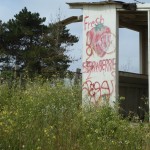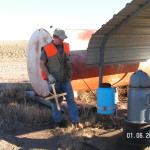
Richard Crossley/Wikimedia
Christmas time draws nature-lovers outdoors to watch the sky. They are uninterested in magical sleigh rides, however — their binoculars follow flocks of birds.
December 14 through January 5 marks the 115th annual Christmas Bird Count in which thousands of avian enthusiasts count bird numbers and species for one day — in California, local bird-lovers organized counting events in 100-plus regions of the state. The counts provide valuable data that scientists use to track changing bird populations from year to year. The emerging patterns can reveal environmental issues, such as habitat fragmentation, that help focus conservation efforts where threatened bird species are at the most risk.
Climate change is one of the factors driving habitat loss. In September 2014, the National Audubon Society released a study that found 170 California bird species at risk of losing climate-sensitive breeding habitats by 2050. Ironically, birders themselves can consume large amounts of fossil fuels per year by traveling thousands of miles in the name of birding. Environmentally thoughtful birders have started a movement to encourage others to reduce their carbon footprint while still enjoying the thrill of spotting new bird species — they call it “green birding.”
“One of the things that’s been cool with green birding is it seems like a great cornerstone for thinking about conservation,” said Robert Furrow, an evolutionary biologist and green birder based in the Bay Area. “It’s just such an obvious connection if you ask a birder to think about not only their hobby, but what are the impacts of their behavior on the environment.”
Green birders travel by foot, bike or canoe to see a diversity of bird species close to home in municipal parks, community gardens or city streets. By staying local, green birders can visit an area regularly without expelling greenhouse gasses. Though it’s probably impossible to know the true impact “regular” birding has on the environment, life-long birder Richard Gregson, author of the book “Green Birding,” estimated that birders from the United States, Canada and Europe put 11,000 tons of carbon dioxide into the atmosphere every year. “Estimates, rough estimates they may be but worrying enough to give us all cause to pause and think,” Gregson wrote on his website www.greenbirding.ca. He continued that most birders would probably feel guilty if they knew these figures because most are “worried about the effects of anthropogenic climate change on the ability of bird populations to prosper.”
These carbon-conscious individuals maintain the environmentalist tradition of the birding community. Indeed, the Christmas Bird Count itself began as an early conservation movement led by ornithologist Frank Chapman of the Audubon Society. In response to a popular tradition that Chapman described as sport hunters going “on the cheerful mission of killing practically everything in fur or feathers that crossed their path,” he proposed that families go outdoors to count birds to preserve populations rather than obliterate them.
The world has changed drastically since the first Christmas Count in 1900 and our feathered friends face new challenges. Luckily, birders are avid citizen scientists that report their observations to online databases, such as eBird, to increase understanding of bird abundance and diversity. California Audubon used such data to identify more than 10 million acres of essential bird habitat that serve as important areas for breeding, wintering and migrating bird populations. By anticipating how climate change could impact such areas, conservationists can prioritize their efforts toward areas that will most effectively support climate-sensitive bird habitats.
Furrow believes that green birding could help people become aware of local nature’s value in maintaining bird habitat and diversity and cause them to care about preserving open spaces.
“You start to focus more on an appreciation for more micro-ecosystems, you know, like little parks and seeing the value of those,” he said. “It seems like it creates a natural dialog about human impacts and potential ways to think about managing resources better or consuming less.”
Eventually, the community may declare that a large carbon footprint is for the birds.







Comments are closed.